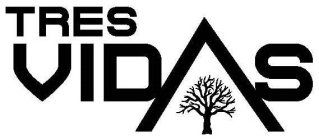A recent application before the United States Patent and Trademark Office sought to register the mark Tres Vidas (with a tree) for tequila and tequila infused with vitmanis in International Class 33. See In re Tres Vidas Organic, Inc., Serial No. 86609789 (August 5, 2016) [not precedential ]. The English translation is “three lives.” The application for registration was originally refused by the Examining Attorney under Section 2(d) of the Trademark Act, 15 U.S.C. § 1052(d), on the ground that Applicant’s mark (when applied to the identified goods) resembles a prior registration for DOS VIDAS for tequila and thus likely to cause confusion, mistake, or to deceive. The mark in the DOS VIDAS registration also contained a translation indicating that it translated to, “two lives.”
]. The English translation is “three lives.” The application for registration was originally refused by the Examining Attorney under Section 2(d) of the Trademark Act, 15 U.S.C. § 1052(d), on the ground that Applicant’s mark (when applied to the identified goods) resembles a prior registration for DOS VIDAS for tequila and thus likely to cause confusion, mistake, or to deceive. The mark in the DOS VIDAS registration also contained a translation indicating that it translated to, “two lives.”
In the Board’s short likelihood of confusion analysis, it considered the goods/channels of trade and the similarity/dissimilarity of the marks. With respect to relatedness of the goods, the Board easily found that the goods were “identical-in-part and legally identical.” Id. at 3. Therefore, the Board presumed that the channels of trade and classes of purchasers were the same. Applicant did not dispute this and the Board found that these particular factors weighed heavily in favor of finding a likelihood of confusion.
Next, the Board considered the similarity and dissimilarity of the mark. In this type of analysis, the Board looks to the appearance, sound, connotation, and commercial impression of the marks in their entireties. The test is not whether the marks can be distinguished from a side-by-side comparison but instead whether the marks are sufficiently similar in terms of their overall commercial impression so that confusion as to the source of the goods is likely to result. In this type of analysis, the focus is on the average consumer who retains a general rather than a specific impression of the marks. When, as in this case, the goods are identical in part, the degree of similarity between the marks that is required to support a likelihood of finding of likelihood of confusion is less than if the goods were no identical.
The Board recognized that, while Applicant’s mark contained a tree, in instances where there is both a word mark and a design mark, the words are generally given greater weight because such would be used by the consumer to request a product. Id. at 5. “With this in mind, we find that, on their face, the literal portions of the marks are similar in sight and sound in that they share the term ‘VIDAS.’ Applicant does not contest that its mark means ‘three lives’ whereas the mark in the cited registration means ‘two lives.'” Id.
Applicant creatively argued that the marks had more “mystical” meanings and that Tres Vidas would be understood as referring to “Mesoamerican religious and cultural concept of three worlds where the tree acts as a symbol for life.” Id. With the support of several third-party resources, Applicant argued that the commercial impression of Tres Vidas would be understood by consumers to refer to Mesoamerican concept of cycle of life, death, and regeneration (along with the tree design). Id. at 6. The Board noted that this logic failed because the mark itself was not “Tree of Life” to “Axis Mudi” or similar. On top of that, the Board observed there was no evidence submitted by Applicant that suggested consumers are aware of Mesoamerican theology or that they would associate Applicant’s mark with a specific cultural or religious concept. Instead, the Board reasoned that consumers would associate the mark with “three lives” and the tree as a living tree associated with lives or living. Id.
Applicant also argued that the registered mark (Dos Vidas) meant double life and not just “two lives,” but the Board rejected this argument because no evidence was presented to support this. Therefore, the Board reasoned that the commercial impressions of the marks were similar and that consumers would expect Applicant’s Tres Vidas mark and design for tequila to be an extension of or associated with Registrant’s Dos Vidas tequila. The Board found the marks to be similar in sight, sound, connotation, and commercial impression and thus in favor of finding a likelihood of confusion. The Examining Attorney’s refusal to register Applicant’s mark under Section 2(d) of the Trademark Act was affirmed.
For more information on wine or alcohol law, or trademarks, please contact Lindsey Zahn.
DISCLAIMER: This blog post is for general information purposes only, is not intended to constitute legal advice, and no attorney-client relationship results. Please consult your own attorney for legal advice.